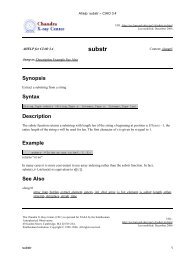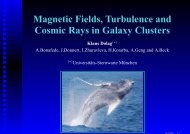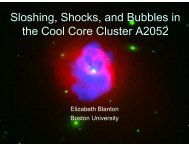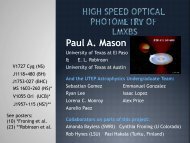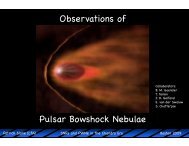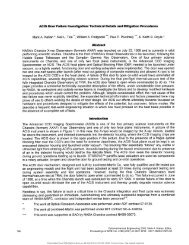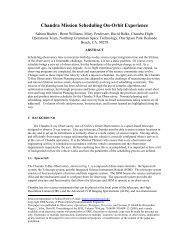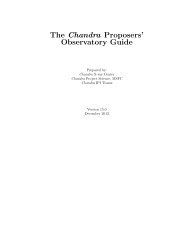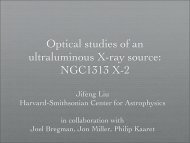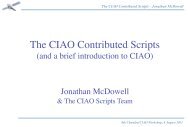PDF Version - Chandra X-Ray Observatory (CXC)
PDF Version - Chandra X-Ray Observatory (CXC)
PDF Version - Chandra X-Ray Observatory (CXC)
Create successful ePaper yourself
Turn your PDF publications into a flip-book with our unique Google optimized e-Paper software.
Spring, 2012<br />
combined in order to see if there were significant<br />
remaining residuals. Fig 3 shows the result. While<br />
there are possible systematic errors of up to 5% over<br />
the 0.5–7 keV range, most of the deviations are less<br />
than 3%. Residuals to simple fits to the other AGN<br />
(not shown) are also less than 3% over most of the<br />
0.5–7 range and only as large as 5% near 0.7 keV.<br />
Thus, an approximate limit to relative systematic errors<br />
is about 3–5% over the HETGS range. While<br />
these residual errors will be examined further to see<br />
if they can be eliminated, another area of investigation<br />
will be the cross-dispersion selection efficiency,<br />
which is currently applied in the grating RMFs.<br />
Recent HETGS Highlights<br />
The High Energy Transmission Grating<br />
Spectrometer continues to provide excellent spectra<br />
for detailed examination of source properties. Over<br />
the past year, papers have appeared on warm ionized<br />
winds in AGN 2, 3, 8 , the distance and dust to Cyg<br />
X-1 7 , O star winds 5,6 , and an accretion shock at the<br />
surface of V2129 Oph, a classical T Tauri star 4 .<br />
The T Tauri result is highlighted in Fig. 4,<br />
which shows the spatial distribution of the two X-ray emitting<br />
plasma components of V2129 Oph. Left and right cartoons<br />
correspond to the viewing angles of two <strong>Chandra</strong> observing<br />
segments, with observer in the rightward direction<br />
4 . Red region marks the post-shock high density plasma at<br />
3−4 MK, blue regions indicate low density coronal plasma<br />
with T ranging from 2 up to ∼30 MK. The emission measure<br />
(EM) distributions derived from HETGS spectra corresponding<br />
to the two observing segments. Red EM bins<br />
symbolize observed EM values ascribed to post-shock plasma,<br />
while blue bins represent those accounting for coronal<br />
plasma. During segment 1, the pre-shock material does not<br />
block the view of both post-shock and coronal plasma: the<br />
EM distribution is therefore the sum of the EM distributions<br />
of the two components. During segment 2, the preshock<br />
material almost completely absorbs the X-rays of<br />
the post-shock plasma emitted toward the observer, while<br />
coronal emission is mostly unaffected: in this case, all the<br />
X-rays detected are those produced by coronal plasma; the<br />
reconstructed EMD, being only those of coronal plasma,<br />
hence misses the high EM values at 3–4 MK.<br />
References<br />
[1] Perlman, E. S., et al. (2005). ApJ 625:727.<br />
[2] Zhang, S. N., Ji, L., Marshall, H. L., et al. (2011). MNRAS<br />
410:2274.<br />
[3] Mocz, P., Lee, J. C., Iwasawa, K., & Canizares, C. R. (2011).<br />
ApJ 729:30.<br />
Fig. 4 - The emission measure (EM) distributions (below) and schematics<br />
of the physical model (above) are shown for two observations of the<br />
classical T Tauri star V2129 Oph. Most of the emission is from coronal<br />
gas (blue). EM with T of 3–4 MK is attributed to the base of the accretion<br />
stream (right panel, in red), observable in segment 1 but obscured by the<br />
upper part of the accretion stream during the 2nd observation (dashed<br />
red line in lower right panel). See Argiroffi et al. [4] for details.<br />
13<br />
[4] Argiroffi, C., Flaccomio, E., Bouvier, J., et al. (2011). A&A<br />
530:A1.<br />
[5] Mitschang, A. W., Schulz, N. S., Huenemoerder, D. P., Nichols,<br />
J. S., & Testa, P. (2011). ApJ 734:14.<br />
[6] Cohen, D. H., Gagné, M., Leutenegger, M. A., et al. (2011).<br />
MNRAS 415:3354.<br />
[7] Xiang, J., Lee, J. C., Nowak, M. A., & Wilms, J. (2011). ApJ<br />
738:78.<br />
[8] Zhang, S.-N., Gu, Q.-S., Ji, L., & Peng, Z.-X. (2011). Research<br />
in Astronomy and Astrophysics 11:1171.<br />
LETG<br />
Jeremy J. Drake, for the LETG Team<br />
1. Ungainly Aging<br />
Its not unusual for the aging process to cause things to<br />
sag and droop. We will not know how many <strong>Chandra</strong> years<br />
makes one human year until the mission ends, but hopefully<br />
its only about 3 or 4. There is no getting around it<br />
though: after 12 years in orbit <strong>Chandra</strong> is firmly in middle<br />
age.<br />
The HRC-S was born a year or so before the <strong>Chandra</strong><br />
launch, and its aging process began much earlier than



